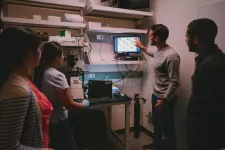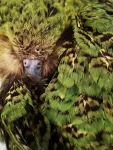(Press-News.org) As fascinating as it is to work in a modern biology lab, in many cases a lot of repetitive, detailed work is necessary before the research can start. For example, cancer researchers are now capable of using hundreds or even thousands of small, lab-grown tumor samples – known as organoids – to test multiple cancer therapies, including immunotherapies, at once.
To produce organoids, researchers often need to mince a fresh tumor into small pieces by hand, using scissors to snip, snip, snip the specimen down to submillimeter size. This dissection work is tedious and yet often done by skilled – and usually overqualified – graduate students or research scientists.
Those days of drudgery may soon be past as researchers at the Stanford School of Engineering have developed two new tools that accelerate the precision cutting of tumor samples into submillimeter-scale organoids. Introducing: the microDicer (µDicer) and the microGrater (µGrater). The inventors believe these tools, not unlike familiar utensils used in kitchens everywhere to dice vegetables or grate cheese, will allow researchers to improve the consistency and quality of samples, which have direct impact on the quality of the data from downstream experiments such as measurements of drug response.
“Our collaborator and co-author Calvin Kuo, co-lead of the Cancer Biology Program at the Stanford Cancer Center, has shown that in cancer immunotherapy research, maintaining the spatial relationships between groups of tumor cells and immune cells that have already infiltrated the tumor – as opposed to working with individual cells – is really important for accuracy in testing drugs and immunotherapies. Our tools help researchers more efficiently create organoids that maintain those relationships,” says Sindy Tang, an associate professor of mechanical engineering and senior author of a study appearing in the journal Microsystems & Nanoengineering describing the microDicer and the microGrater.
“These new tools will speed up the manual lab work, but their utility goes beyond that obvious advantage,” Tang added. “These tools produce uniform sized organoids and the blades can be varied to whatever size the researcher requires.”
Having precise control on organoid size allows researchers to ask the question whether there is a “perfect” organoid size. If the organoid is too small, it may not retain the original properties of the tumor as it existed in the body. If the organoid is too big, however, it may die due to the difficulty of oxygen and nutrients getting through to the interior tumor cells.
Precise blades
Tang and her team fashioned the blades of the microDicer in silicon using micromachining tools of classical computer chipmaking. The blade patterns are etched into silicon using a reactive plasma. The blades of the microGrater are made of stainless steel.
Scanning microscopy images of the microDicer (blade spacings 200 μm, 400 μm, and 800 μm, respectively) and microGrater. | Seth Cordts and Saisneha Koppaka
The microDicer’s blade looks like a mesh of vertical, interlocking hexagons, resembling a honeycomb with sharpened edges. To use the microDicer, the researcher shaves off thin layers of tissue that are then pressed through the microDicer’s honeycomb mesh to produce precise, uniform tumor samples.
The microGrater’s array of blades, on the other hand, boasts a series of neat, rounded rectangles a bit more than half a millimeter long; the edges of each rounded rectangle are beveled to form the blades that shave off precise organoids as the tissue is moved back and forth across the grater.
Future promise
The tumor samples Tang and her colleagues are studying are grown in lab mice and are a good model of human tumors. The ultimate goal is a sort of bespoke, personalized cancer therapy in which samples are gathered from a specific patient to test which immunotherapies will work best for them. By standardizing the process flow and organoid sizes in a way that manual mincing cannot, these new tools can expedite approval from regulatory agencies, like the FDA, for broader use, Tang says.
Her most recent work building upon these technologies will look to identify the ideal size for organoids across different tissue types. It is possible that different cancers and tissues have different dimensional requirements, a parameter that the flexibility of Tang’s tools should help address. She can fine-tune the blades to make organoids of pretty much any size between a few hundred micrometers and a millimeter. Furthermore, she is now investigating how the shape of the blades affects the fidelity of the cuts. The physics of cutting soft biological tissues is a difficult problem and not well understood.
Once Tang had the idea for the microDicer, she turned the prototyping process into a graduate-level product design class, ENGR 241: Advanced Micro and Nano Fabrication Laboratory, taught by Roger Howe and Jonathan Fan. In that class, PhD students learned to make micro-scale devices in a hands-on, project-based environment in the Stanford Nanofabrication Facility. Several of Tang’s students are co-authors on the paper.
The microDicer and microGrater are not Tang’s first mechanical tools for biological purposes. She made headlines a few years back with another tool – a cellular guillotine – able to split individual cells in two to study how single cells heal. That invention drew considerable interest from other biology labs inquiring the possibility of cutting tissues, which motivated the development of the microDicer and microGrater. She is now evaluating ways to disseminate the tools to the research community, including the possibility of bringing the tools to market.
Additional co-authors are PhD student Seth Cordts, postdoctoral fellow Kanako Yuki, School of Medicine researcher Maria Henao Echeverri, and Balasubramanian Narasimhan, who is a senior research scientist in the Department of Statistics and the Department of Biomedical Data Sciences. Balasubramanian is also a member of the Stanford Cancer Institute. Kuo is the Maureen Lyles D’Ambrogio Professor in the School of Medicine. He is also a member of Stanford Bio-X, the Cardiovascular Institute, the Maternal & Child Health Research Institute (MCHRI), Stanford Medicine Children’s Health Center for IBD and Celiac Disease, the Stanford Cancer Institute, and the Wu Tsai Neurosciences Institute. Tang is also a senior fellow of the Stanford Woods Institute for the Environment, a member of Bio-X and the Wu Tsai Human Performance Alliance, and a faculty fellow of Sarafan ChEM-H.
The work was supported financially by a Stanford Bio-X Interdisciplinary Initiatives Seed Grant, the Stanford Center for Cancer Nanotechnology Excellence for Translational Diagnostics seed grant, Stanford Beckman Center Technology Development Seed Grants, and the National Cancer Institute of the National Institutes of Health.
END
MicroDicer and MicroGrater make quick work of tumor dissection
2024-09-10
ELSE PRESS RELEASES FROM THIS DATE:
Phase II study of taletrectinib shows clinically meaningful overall response and favorable safety in patients with ROS1+ non-small cell lung cancer
2024-09-10
(San Diego, Calif.--September 10, 2024, 10:35 a.m. PCT) – The ROS1 tyrosine kinase inhibitor (TKI) taletrectinib demonstrated high overall and intracranial responses, and a favorable safety profile with low incidence of neurologic adverse events in TKI-naive and TKI-pretreated patients with ROS1+ non-small cell lung cancer (NSCLC).
These results were presented today at the International Association for the Study of Lung Cancer 2024 World Conference on Lung Cancer by Dr. Geoffrey Liu, from Princess Margaret Cancer Centre, ...
LUMINOSITY trial demonstrates telisotuzumab vedotin shows durable response in Asian patients with c-Met protein-overexpressing EGFR WT nonsquamous NSCLC
2024-09-10
LUMINOSITY Trial Demonstrates Telisotuzumab Vedotin Shows Durable Response in Asian Patients with c-Met Protein-Overexpressing EGFR WT Nonsquamous NSCLC
(San Diego, Calif.--September 10, 2024 10:35 a.m.) -- The c-Met-directed antibody-drug conjugate telisotuzumab vedotin demonstrated durable responses and an acceptable safety profile in patients of Asian race with c-Met protein-overexpressing, epidermal growth factor receptor (EGFR) wildtype (WT), locally advanced/metastatic nonsquamous non-small cell ...
PM2.5 exposure may affect lung cancer in women who have never smoked
2024-09-10
(San Diego, Calif.--September 10, 2024, 10:35 a.m. PCT) – Recent air pollution exposure in the form of particles smaller than 2.5 micrometers (PM2.5) exposure may significantly impact lung cancer in women who have never smoked, with notable differences in stage IV diagnoses among EGFR+ patients, according to research presented today at the International Association for the Study of Lung Cancer (IASLC) 2024 World Conference on Lung Cancer.
The International Agency for Research on Cancer (IARC) categorized outdoor air pollution and its key component, particulate matter PM2.5, as Group 1 carcinogens in 2013, indicating that they cause lung cancer. Associations between ...
Results from CARMEN-LC03 phase 3 study of tusamitamab ravtansine vs. docetaxel in previously treated advanced non-squamous NSCLC presented at WCLC 2024
2024-09-10
(San Diego, Calif.--September 10, 2024, 10:35 a.m. PCT) A phase 3 study comparing tusamitamab ravtansine with docetaxel in patients with advanced non-squamous non-small cell lung cancer (NSCLC) previously treated with platinum-based chemotherapy and immunotherapy (in combination or sequential), whose tumors highly expressed CEACAM5, is presented today at the International Association for the Study of Lung Cancer 2024 World Conference on Lung Cancer in San Diego, Calf., by Dr. Benjamin Besse of Gustave Roussy, in Paris, France. As previously announced by Sanofi in December 2023, ...
Partial knee replacements for osteoarthritis performed by trainee surgeons last as long as those performed by more experienced consultants
2024-09-10
Partial knee replacements for osteoarthritis performed by trainee surgeons last as long as those performed by more experienced consultants, according to data from England and Wales suggesting no difference in rates of subsequent revision surgery
#####
In your coverage, please use this URL to provide access to the freely available paper in PLOS Medicine: http://journals.plos.org/plosmedicine/article?id=10.1371/journal.pmed.1004445
Article Title: Association between surgeon training grade and the risk of revision following unicompartmental knee replacement: ...
New Zealand’s kākāpō developed different feather colors to evade predatory birds
2024-09-10
Aotearoa New Zealand’s flightless parrot, the kākāpō, evolved two different color types to potentially help them avoid detection by a now-extinct apex predator, Lara Urban at Helmholtz AI, Germany and colleagues from the Aotearoa New Zealand Department of Conservation and the Māori iwi Ngāi Tahu, report in the open-access journal PLOS Biology, publishing September 10th.
The kākāpō (Strigops habroptilus) is a nocturnal, flightless parrot endemic to New Zealand. It experienced severe population ...
Unaffordable food putting mums-to-be at risk
2024-09-10
Embargoed until Tuesday September 10 at 19:00 (BST)
Pregnant women who have limited access to affordable, nutritious, and healthy foods have a higher chance of developing both physical and mental health problems.
New research from Newcastle University has found that women who are what is termed “food insecure” are up to four times more likely to have poor mental health - such as stress, anxiety, and depression - than those who don’t struggle to afford or access food.
The mums-to-be are also at increased risk of obesity, developing diabetes during their pregnancy and dental problems, the two studies published ...
Viruses to enhance crop performance
2024-09-10
Humans, livestock and companion animals benefit from virus-based vaccines and gene therapies, but crops do not. This paradox is highlighted by an international research group led by the Institute of Molecular and Cellular Biology of Plants (IBMCP) within the Spanish National Research Council (CSIC), in an article published in the prestigious journal Nature Reviews Bioengineering. The study proposes a roadmap to use attenuated viruses to enhance performance of crops, making them more resistant to extreme and changing climate ...
Pharmacy benefit manager market concentration for prescriptions filled at US retail pharmacies
2024-09-10
About The Study: In 2023, all 3 payer markets (commercial insurance, Medicare Part D, and Medicaid managed care) for pharmacy benefit manager (PBM) services were highly concentrated, but concentration varied and was highest in Medicare Part D. While CVS Caremark held the dominant share in all 3 payer markets, each of the PBMs appeared focused on a different payer: Express Script’s largest share was in the commercial market, while Optum Rx’s and CVS Caremark’s were in Medicare Part D and Medicaid ...
New research shows new class of once-weekly insulin as effective as daily injections for patients with type 2 diabetes
2024-09-10
New research published in NEJM and presented at this year’s Annual Meeting of the European Association for the Study of Diabetes (EASD) in Madrid (9-13 Sept) shows that a new class of insulin that is injected once a week is as effective as daily insulin injections for effective and safe blood sugar management in patients with type 2 diabetes. The study is by Dr Carol Wysham, MultiCare Rockwood Center for Diabetes and Endocrinology, Spokane, WA, USA, and colleagues.
When patients with type 2 diabetes find their oral medications alone can no longer control their blood sugar, insulin therapy is added and injection frequency (having daily injections) is among the main factors that can contribute ...








